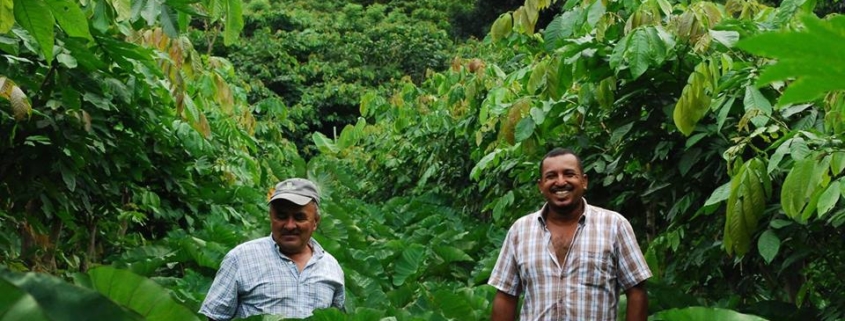The Inga Foundation: Changing Lives in a Revolutionary Way
Mike Hands of the Inga Foundation, a Regeneration International (RI) partner, works in Honduras with slash-and-burn farmers who average 20 acres (eight hectares) of land holdings. That’s considerably larger than most slash-and-burn farms, which Mike estimates are no bigger than five acres (two hectares).
If you use that two-hectare figure as a benchmark, and multiply it by the 300 million slash-and-burn farms worldwide, you’ve got 1.5 billion acres. That’s a lot of slash-and-burn acreage—acreage that with better farming practices, could be turned into carbon-sequestering farms.
According to Hands, converting from slash and burn to the Inga Foundation’s Guama (Spanish for inga tree) farming method sequesters about 35 tons of carbon per acre per year over a 12-year period.
Multiply that by 1.5 billion acres, and if every slash-and-burn farm worldwide were to convert to the Inga Foundation’s Guama model, it could sequester as much as 52.5 billion tons (gigatons) of CO2 over a 12-year period.
According to the U.S. National Oceanic and Atmospheric Administration, one gigaton of carbon sequestration lowers atmospheric carbon levels by almost .5 parts per million.
So, if all slash-and-burn farmers worldwide were to switch to the Inga Foundation’s Guama model, it would be enough to lower the world’s perilously high carbon level of 400 parts-per-million (ppm) by about 25 ppm, to about 375 ppm, bringing us that much closer to the level of 350 ppm that 350.org is calling for in order to stabilize the world’s climate.
Clearly, the Inga Foundation is on to something.
The Guardian newspaper seems to think so. It ranked Mike Hands #44 on a list of the 100 most important people for saving the world—ahead of such luminaries as Henry David Thoreau, Mahatma Gandhi, Charles Darwin and the Dalai Lama. That’s pretty heady company.
The Inga Foundation is active in Costa Rica, the Congo, the Democratic Republic of the Congo, Madagascar and the U.K.. But the foundation’s biggest project is in Honduras, where it’s working with 300 family farmers. That’s a far cry from 250 million. But it’s a start. And it’s growing.
When I spoke with Mike from his base in the U.K., he said Honduran farmers who have seen the crop yields of their Guama-employing neighbors are lining up to learn Guama techniques and to get Inga Foundation help with getting started—especially in the wake of a major 2016 storm that caused widespread flooding and literally washed away the farms of many non-Guama slash-and-burn farmers.
Slash-and-burn farms tend to be on hillsides, often steep hillsides, where rough terrain, difficult access and vulnerability to washout makes the land less desirable and lessens competition for the land. All of these factors combine to offer at least some degree of protection from the large and expanding palm oil biofuel plantations that often use violence and even murder to displace farmers on the coastal plains of Honduras.
But those advantages come at a cost, and when Guama-employing farmers bounced back from the 2016 storm and a devastating drought that followed the storm, their neighbors took notice, and interest in the Inga Foundation’s methods spiked.
The Guama basics are not hugely complicated. You plant rows of Inga trees—which have extensive, shallow and fast-growing roots systems—between rows of crops, in a method known as alley cropping. This increases soil retention, especially in the face of challenges such as intense rain, droughts and hurricanes. Then you supplement soil nutrition with decomposing foliage of the Inga trees and with mineral supplements, most importantly rock phosphate—not regular, standard phosphate, which washes away much more quickly.
Slash-and-burn is hard on farmers because the land it clears loses soil nutrition so fast that farmers have to clear new lands every 5-7 years. That’s hard work. It disrupts families and family life. And the endless search for new lands to clear and cultivate brings farmers into sometimes violent conflict with other farmers, landowners and indigenous peoples.
Plus every time farmers slash and burn an hectare of land (2.5 acres), at least 100 tons of carbon are released into the atmosphere, according to Mike Hands. And right now the world is watching in horror as this process is being played out—and accelerating—in the Amazon rainforests of Brazil and Bolivia, particularly in Brazil, where the new far-right government of Jair Bolsonaro is turning a blind eye to, or even encouraging, what is often land theft and subsequent illegal burning.
It’s a long way from the Inga Foundation’s 300 families to the global figure of 250 million slash-and-burn farmers. Not surprisingly, Hands says the biggest challenge to the Inga Foundation’s growth is funding. And government bureaucracies aren’t helping either. In Honduras, a Foundation shipment of 18,800 kilos of rock phosphate has been held up in customs since 2017. And the customs and storage fees keep rising, making eventual release of the rock phosphate less and less likely and further and further out of reach.
Despite all the challenges facing the Inga Foundation, Mike Hands is optimistic. “The Guama Model is changing lives and livelihoods in a revolutionary way,”Mike told me. “We estimate that families in our Land for Life Program have planted over 3 million trees since 2012.”
That sounds like a pretty good start.
Lawrence Reichard is a freelance journalist. To keep up with news and events, sign up here for the Regeneration International newsletter.

